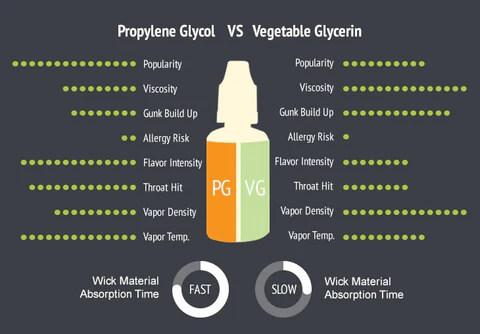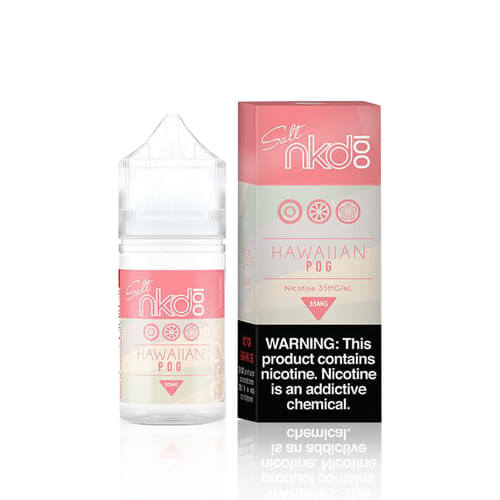PG/VG Ratios: Does it Really Matter?
23rd Jun 2017
PG/VG Ratios: Does it Really Matter?
Perhaps you’re new to vaping and you have no idea what the little ratios and percentages on vape juice bottles mean, or if they even make a difference! Or maybe you’ve been vaping for a little while, but you haven’t really had the time to educate yourself on the differences that these ratios can make in your e-liquids. How do you know which ratio is best? Is it really that big of a difference?
To understand the differences between PG/VG ratios, it’s essential to understand the main properties.
What is PG?
PG stands from propylene glycol. It’s synthetic, odorless, colorless, and has a lower viscosity (thickness) than its counterpart VG. It’s used in a variety of food products, including coffee-based drinks, sodas, and ice cream and dairy products. It’s also a primary ingredient in medical inhalers for asthma and other atomized medications.
You may have heard that PG is used as antifreeze, likely from propaganda designed to demonize vaping. While it’s true that PG can lower the freezing point of water, what the fear mongers won’t tell you is that propylene glycol is used in place of ethylene glycol (another antifreeze component) because it’s <i>not toxic</i>. Animals can be attracted to the sweet-smelling puddles under leaky radiators, and PG is used in some antifreeze to protect dogs, cats, and other critters who might accidentally be allowed to drink some.
What is VG?
VG is vegetable glycerin, which is derived from vegetable oil. Vegetable glycerin has a slightly sweet taste naturally, and a higher viscosity than propylene glycol. Like PG, VG is regarded as non-toxic and can be found in many medical, food, and personal care products.
So What’s the Difference in PG and VG in Vaping?
PG provides ex-smokers with that sharp throat hit that they might be missing since they gave up cigarettes. Since it’s odorless and flavorless, PG holds flavor and nicotine better than VG - most pure flavor extracts are suspended in a PG base, so even high-VG liquids will likely have at least a bit of PG in them from the flavoring. However, if you are a cloud chaser, VG is thick, produces more vapor, and is going to produce larger clouds.
The awesome part about this, is you don’t have to choose clouds over flavor and throat hit, or throat hit and flavor over clouds. That’s what mixes are for!
Check Your Tank
Most tanks out there can handle a good mix of both PG and VG, but just make sure to double check with an expert, and keep in mind that higher VG juices are going to gunk up your tank faster (which will mean more cleaning and sometimes, if not properly used or cared for, some device maintenance issues). Also, since they require more heat, you might find yourself running out of juice faster than you had anticipated. A higher-PG juice is going to have a sharper throat hit, so be aware of that as well in case you find that it’s somewhat irritating to your throat.
Some tanks that use a lower wattage are not suitable for a higher VG juice, due to the thickness being incompatible with the usually-smaller wicking that can’t absorb the thick liquid fast enough to prevent drying out. In this scenario you might burn out the coils and end up with nasty, dry hits. Just make sure to research your device and understand the limits of your tank.
PG/VG Ratios
NKD 100 Salt E-Liquid - Hawaiian POG
100% PG and 100% VG are not as popular for most vapers as mixes are, simply because there are typically drawbacks to either one in it’s pure form (if you enjoy both a throat hit and larger clouds, this is definitely an issue). 100% PG provides the sharpest throat hit and packs a punch with stronger flavor, but you won’t be seeing huge clouds. 100% VG is going to be a little more muted in flavor, with hardly any throat hit, but it is used in competitive cloud chasing, as it offers the greatest production of clouds. Remember, though, that unless the juice you’re using is unflavored (some cloud competition entrants vape straight, unflavored VG) it’s likely to have some PG content.
80/20 PG/VG mix is going to give a bit more cloud production, and a little less of a throat hit than 100% PG. 20/80 PG/VG is going to have very little throat hit, a lot of vapor production, but probably a more muted, less enjoyable flavor.
70/30 PG/VG mix is a nice ratio if you want a strong throat hit, lots of flavor, and some of that cloud production. 30/70 is a common mix for cloud chasers who want a little throat hit, but still have that smooth quality from the higher VG percentage.
50/50 PG/VG is the sweet spot in the middle, and this is a great starting point if you aren’t really sure what your preference is yet.
Remember, like everything else, taste is subjective - some folks are much more aware of a muted flavor in high-VG liquids, others don’t notice the drop-off in flavor nearly as much.
Another concern is that, while rare, some people experience sensitivities to either PG or VG. Take a look at this post, where we examine in detail some of the side effects one might feel and how to alleviate them. It’s much more common for new vapers to experience a reaction to PG, though VG sensitivity does exist as well.
Now that you know the basics, just remember the differences between PG and VG, and find that awesome mix that suits you!



